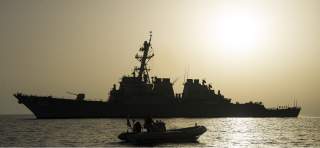Northrop Grumman Has a Funky New Weapon to Add More Firepower to the U.S. Navy
And it just passed a major milestone.
A futuristic reconnaissance drone designed to fly both vertically and horizontally off of small U.S. ships has passed a pair of procurement milestones, contractor Northrop Grumman said this week.
The company is developing the Tern intelligence, reconnaissance and surveillance (ISR) drone under the supervision of the Office of Naval Research and the Defense Advanced Research Projects Agency.
Northrop Grumman said it completed two critical design reviews in mid-October. The first was for a derivative design of a General Electric turbo-shaft engine that would allow Tern to be launched from a "tall-sitter" configuration off of Navy and Marine Corps ships.
The second design review covered the drone's hardware and software architecture needed to launch the craft vertically off ships before transitioning to horizontal flight, the company said. That vertical takeoff and landing (VTOL) capability would help solve a key limitation of long-range drones: the requirement for runway.
Along with ISR missions, the services envision deploying Tern to conduct long range "light strike" missions at ranges beyond 600 nautical miles. Northrop Grumman said the milestones help keep the program on track for demonstration flights to begin in 2018.
The third phase of a DARPA contract calls for Northrop Grumman to complete a detailed aircraft design and deliver two demonstrator aircraft. They would be used for land testing and ship-based demonstrations of drone launch and recovery.
The flying-wing design incorporates twin counter-rotating propellers mounted on Tern's nose. The propellers would lift the aircraft, move it into position for horizontal flight, and then operate again vertically upon landing.
The shift to drone technology for ISR mission reflects the Navy's strategy of allowing surface ships to conduct surveillance and targeting missions without the aid of land- or carrier-based patrol aircraft. Tern also is intended to support Marine expeditionary missions using long-range, high-endurance unmanned aircraft.
The Navy envisions deploying Tern on Arleigh Burke-class destroyers, which have several helicopter pads but no runways. Researchers also are hoping that the program can save money by allowing ships to host the aircraft without any significant modifications.
The VTOL drone program is based on a research effort launched by DARPA in 2014 dubbed Tactically Exploited Reconnaissance Node. According to the agency, Tern would provide small ships with a "mission truck" for hauling ISR and strike payloads long distances. "It would be able to operate from multiple ship types in elevated sea states," DARPA program officials said.
Tern is the second research effort co-sponsored by DARPA and the Navy to advance in the last two months. In October, the research agency said a new sensor suite dubbed Towed Airborne Lift of Naval Systems, or TALONS, was deployed by an antisubmarine warfare drone ship during a demonstration.
This first appeared in DefenseSystems here.

